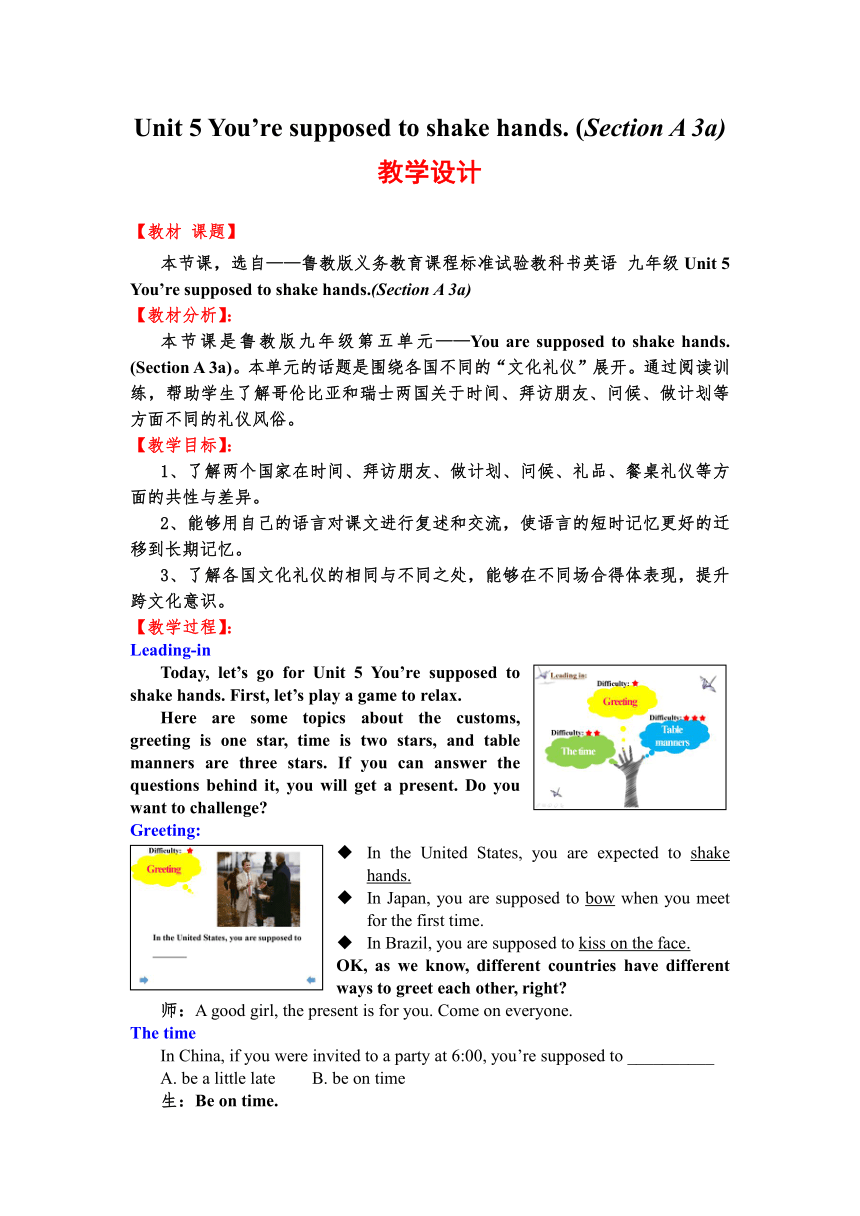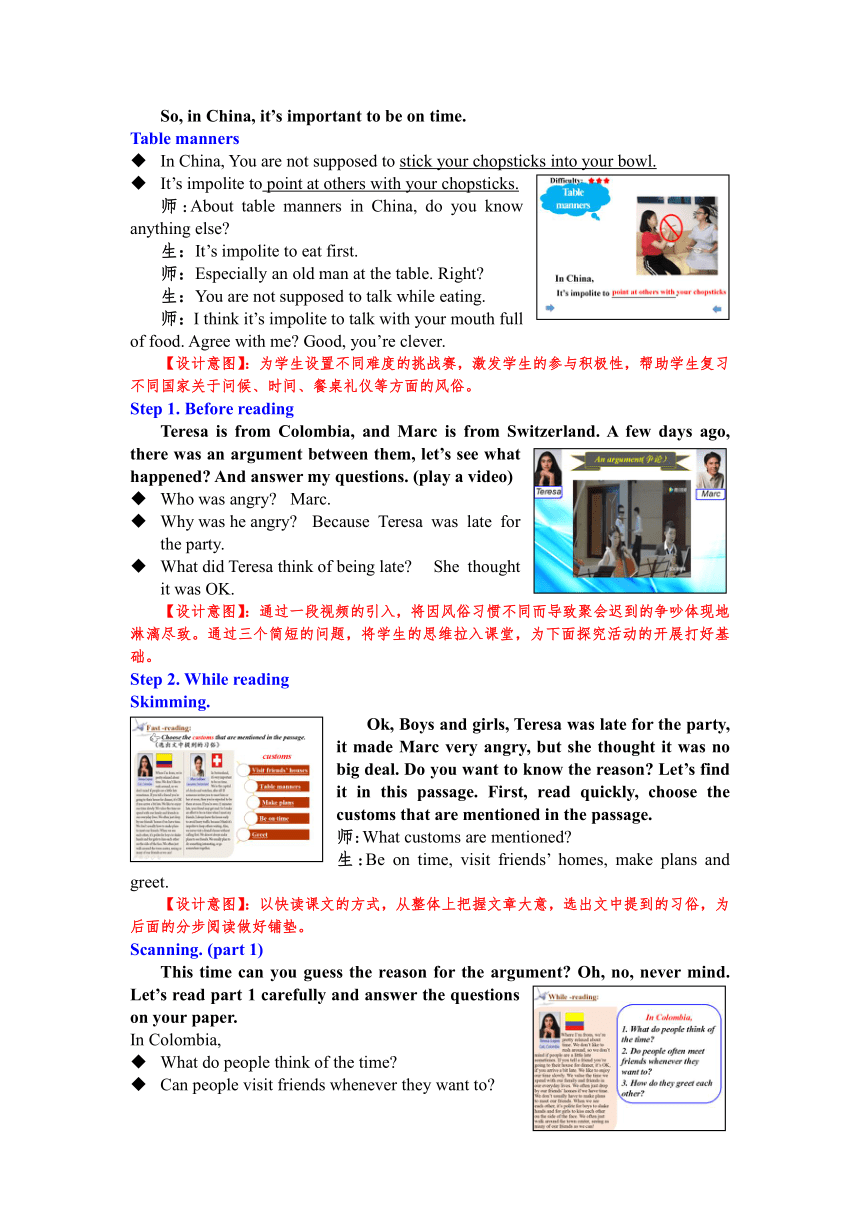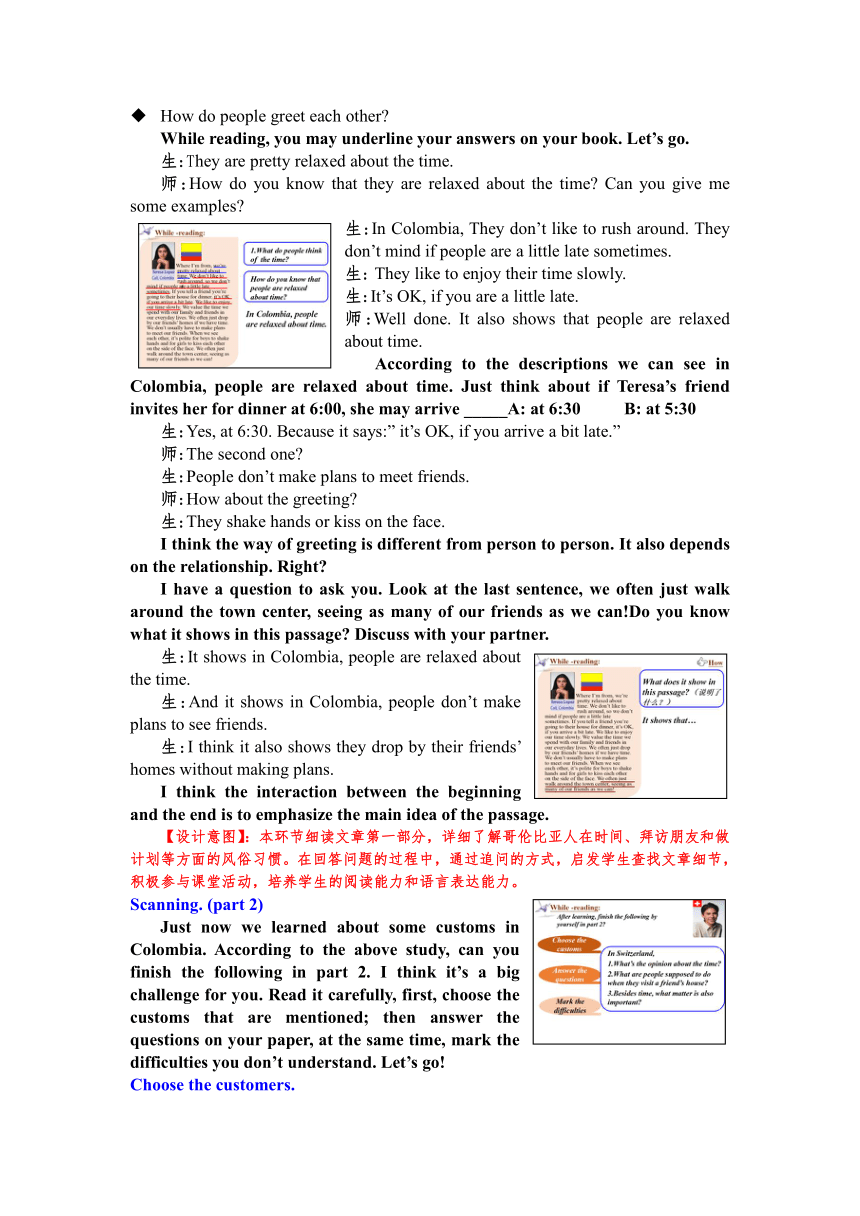鲁教版九年级全册 Unit 5 You're supposed to shake hands. Section A 教案
文档属性
| 名称 | 鲁教版九年级全册 Unit 5 You're supposed to shake hands. Section A 教案 |  | |
| 格式 | doc | ||
| 文件大小 | 1.1MB | ||
| 资源类型 | 教案 | ||
| 版本资源 | 鲁教版 | ||
| 科目 | 英语 | ||
| 更新时间 | 2022-10-12 10:07:46 | ||
图片预览



文档简介
Unit 5 You’re supposed to shake hands. (Section A 3a) 教学设计
【教材 课题】
本节课,选自——鲁教版义务教育课程标准试验教科书英语 九年级Unit 5 You’re supposed to shake hands.(Section A 3a)
【教材分析】:
本节课是鲁教版九年级第五单元——You are supposed to shake hands. (Section A 3a)。本单元的话题是围绕各国不同的“文化礼仪”展开。通过阅读训练,帮助学生了解哥伦比亚和瑞士两国关于时间、拜访朋友、问候、做计划等方面不同的礼仪风俗。
【教学目标】:
1、了解两个国家在时间、拜访朋友、做计划、问候、礼品、餐桌礼仪等方面的共性与差异。
2、能够用自己的语言对课文进行复述和交流,使语言的短时记忆更好的迁移到长期记忆。
3、了解各国文化礼仪的相同与不同之处,能够在不同场合得体表现,提升跨文化意识。
【教学过程】:
Leading-in
Today, let’s go for Unit 5 You’re supposed to shake hands. First, let’s play a game to relax.
Here are some topics about the customs, greeting is one star, time is two stars, and table manners are three stars. If you can answer the questions behind it, you will get a present. Do you want to challenge
Greeting:
In the United States, you are expected to shake hands.
In Japan, you are supposed to bow when you meet for the first time.
In Brazil, you are supposed to kiss on the face.
OK, as we know, different countries have different ways to greet each other, right
师:A good girl, the present is for e on everyone.
The time
In China, if you were invited to a party at 6:00, you’re supposed to __________
A. be a little late B. be on time
生:Be on time.
So, in China, it’s important to be on time.
Table manners
In China, You are not supposed to stick your chopsticks into your bowl.
It’s impolite to point at others with your chopsticks.
师:About table manners in China, do you know anything else
生:It’s impolite to eat first.
师:Especially an old man at the table. Right
生:You are not supposed to talk while eating.
师:I think it’s impolite to talk with your mouth full of food. Agree with me Good, you’re clever.
【设计意图】:为学生设置不同难度的挑战赛,激发学生的参与积极性,帮助学生复习不同国家关于问候、时间、餐桌礼仪等方面的风俗。
Step 1. Before reading
Teresa is from Colombia, and Marc is from Switzerland. A few days ago, there was an argument between them, let’s see what happened And answer my questions. (play a video)
Who was angry Marc.
Why was he angry Because Teresa was late for the party.
What did Teresa think of being late She thought it was OK.
【设计意图】:通过一段视频的引入,将因风俗习惯不同而导致聚会迟到的争吵体现地淋漓尽致。通过三个简短的问题,将学生的思维拉入课堂,为下面探究活动的开展打好基础。
Step 2. While reading
Skimming.
Ok, Boys and girls, Teresa was late for the party, it made Marc very angry, but she thought it was no big deal. Do you want to know the reason Let’s find it in this passage. First, read quickly, choose the customs that are mentioned in the passage.
师:What customs are mentioned
生:Be on time, visit friends’ homes, make plans and greet.
【设计意图】:以快读课文的方式,从整体上把握文章大意,选出文中提到的习俗,为后面的分步阅读做好铺垫。
Scanning. (part 1)
This time can you guess the reason for the argument Oh, no, never mind. Let’s read part 1 carefully and answer the questions on your paper.
In Colombia,
What do people think of the time
Can people visit friends whenever they want to
How do people greet each other
While reading, you may underline your answers on your book. Let’s go.
生:They are pretty relaxed about the time.
师:How do you know that they are relaxed about the time Can you give me some examples
生:In Colombia, They don’t like to rush around. They don’t mind if people are a little late sometimes.
生: They like to enjoy their time slowly.
生:It’s OK, if you are a little late.
师:Well done. It also shows that people are relaxed about time.
According to the descriptions we can see in Colombia, people are relaxed about time. Just think about if Teresa’s friend invites her for dinner at 6:00, she may arrive _____A: at 6:30 B: at 5:30
生:Yes, at 6:30. Because it says:” it’s OK, if you arrive a bit late.”
师:The second one
生:People don’t make plans to meet friends.
师:How about the greeting
生:They shake hands or kiss on the face.
I think the way of greeting is different from person to person. It also depends on the relationship. Right
I have a question to ask you. Look at the last sentence, we often just walk around the town center, seeing as many of our friends as we can!Do you know what it shows in this passage Discuss with your partner.
生:It shows in Colombia, people are relaxed about the time.
生:And it shows in Colombia, people don’t make plans to see friends.
生:I think it also shows they drop by their friends’ homes without making plans.
I think the interaction between the beginning and the end is to emphasize the main idea of the passage.
【设计意图】:本环节细读文章第一部分,详细了解哥伦比亚人在时间、拜访朋友和做计划等方面的风俗习惯。在回答问题的过程中,通过追问的方式,启发学生查找文章细节,积极参与课堂活动,培养学生的阅读能力和语言表达能力。
Scanning. (part 2)
Just now we learned about some customs in Colombia. According to the above study, can you finish the following in part 2. I think it’s a big challenge for you. Read it carefully, first, choose the customs that are mentioned; then answer the questions on your paper, at the same time, mark the difficulties you don’t understand. Let’s go!
Choose the customers.
师:What customs are mentioned in this passage
生:be on time; visit friends’ houses; make plans.
Answer the questions.
The first one.
生:In Switzerland, it’s important to be on time.
师:What does Marc do to be on time
生:He often leaves the home early to avoid heavy traffic.
师:Because in Switzerland it’s impolite to keep others waiting. Right
The next one.
生:We can say people are supposed to call first.
The last question.
生:Plans. In Switzerland, people make plans to see friends, do something interesting or go somewhere together.
师:Do you have any difficulties Discuss with your partner.
I think Switzerland is the capital of clocks and watches, so time and plans are very important. Do you agree with me
【设计意图】:细读课文分成两部分进行,以左部分的学习为引领,让学生自主完成右部分的阅读任务。分为三步走的方式:选择风俗、回答问题、标记难点。将课文的阅读扎实推进,充分体现了在用中学,在学中用的教学理念。
Step 3. After reading
Part 1: Finish the chart.
Just now, we know the customs in Colombia and Switzerland. Do you know what their differences are Let’s finish the form to compare.
About being on time
生:In Colombia,people are relaxed about the time.And in Switzerland, it’s important to be on time.
So I think different countries have different time concept(时间观念)
About visiting friends’ houses
生:In Colombia, people drop by friends’ houses, and in Switzerland, people are supposed to call first.
About making plans
生:In Colombia, people don’t make plans to see friends, and in Switzerland, people make plans and plan to do something interesting or go somewhere warm.
【设计意图】:在课文分步学习的基础上,把哥伦比亚和瑞士两个国家的风俗习惯进行横向对比,进一步深化学生对文章的认识和理解。
Part 2: Watch a short show.
Boys and girls, in this passage, we know something different in the country, do you know something the same Let’s watch a short show to find the answers.
师:Have you got it What’s the same
生:Greeting. It’s the same as Switzerland.
生:The gift. When you go to friends’ houses, you are supposed to take some flowers,fruits or some chocolate.
生:Table manners. They eat dinner with forks and knives.
So I think something the same and something different makes up the beautiful world.
【设计意图】:课文中我们学习了哥伦比亚人和瑞士人在风俗上的不同,通过短视频找出两个国家在风俗上的相同之处。将本单元的话题进行归纳,引申出正是民族间、国家间有着许多的相同与不同文化礼仪,才组成了我们美好的世界。
Part 3: Read this passage aloud.
You should pay attention to your pronunciation.
【设计意图】:对课文的大声朗读,培养学生“读”的能力,提升学生的语感,为后面的复述打下基础。
Part 4: Retell the story.
You can choose your favorite lifestyle in Colombia or Switzerland, using the mind-map or this form to practice it with your partner. Then ask three students to show us.
【设计意图】:复述环节是语言的输出环节,以思维导图的形式呈现,可以更好的将两个国家的文化礼仪进行对比。导图的设计分为两个梯度,充分考虑学生的能力差异,让不同层次的学生都有收获。
Part 5: Summary.
From this class, we know these are two different lifestyles in Colombia and Switzerland. Which lifestyle do you like Why do you like it Discuss in your group.
生:I like the lifestyle in Colombia, because we can enjoy the time slowly.
师:I also love the slow life. Because it can make us feel more comfortable. But I think we can enjoy it on the weekend or in the holiday. Right
生:I like the lifestyle in Switzerland, because we can make plans to see friends.
师:I think making plans can save us lots of time, and it can make things more organized.
生:I like the lifestyle in Colombia, because we value the time we spend with our family and friends.
师:I think spending time with family and friends is very important for everyone.
After all, time is gone forever. So as a teenager, we should value our time, and make plans to make our life more organized. Do you agree with me
【设计意图】:这一部分是本节课的小结,通过开放式话题的讨论,加深学生对礼仪的理解,将本节课的情感态度、价值观得到有效升华,提高学生的语言综合运用能力。
板书设计:
【设计意图】:板书以思维导图的形式,直观地将哥伦比亚和瑞士两国的风俗礼仪进行对比,更好地帮助学生理解课文、概括主旨。同时将“各美其美,美人之美,美美与共,天下大同。”的理念渗透到学习中。
【教材 课题】
本节课,选自——鲁教版义务教育课程标准试验教科书英语 九年级Unit 5 You’re supposed to shake hands.(Section A 3a)
【教材分析】:
本节课是鲁教版九年级第五单元——You are supposed to shake hands. (Section A 3a)。本单元的话题是围绕各国不同的“文化礼仪”展开。通过阅读训练,帮助学生了解哥伦比亚和瑞士两国关于时间、拜访朋友、问候、做计划等方面不同的礼仪风俗。
【教学目标】:
1、了解两个国家在时间、拜访朋友、做计划、问候、礼品、餐桌礼仪等方面的共性与差异。
2、能够用自己的语言对课文进行复述和交流,使语言的短时记忆更好的迁移到长期记忆。
3、了解各国文化礼仪的相同与不同之处,能够在不同场合得体表现,提升跨文化意识。
【教学过程】:
Leading-in
Today, let’s go for Unit 5 You’re supposed to shake hands. First, let’s play a game to relax.
Here are some topics about the customs, greeting is one star, time is two stars, and table manners are three stars. If you can answer the questions behind it, you will get a present. Do you want to challenge
Greeting:
In the United States, you are expected to shake hands.
In Japan, you are supposed to bow when you meet for the first time.
In Brazil, you are supposed to kiss on the face.
OK, as we know, different countries have different ways to greet each other, right
师:A good girl, the present is for e on everyone.
The time
In China, if you were invited to a party at 6:00, you’re supposed to __________
A. be a little late B. be on time
生:Be on time.
So, in China, it’s important to be on time.
Table manners
In China, You are not supposed to stick your chopsticks into your bowl.
It’s impolite to point at others with your chopsticks.
师:About table manners in China, do you know anything else
生:It’s impolite to eat first.
师:Especially an old man at the table. Right
生:You are not supposed to talk while eating.
师:I think it’s impolite to talk with your mouth full of food. Agree with me Good, you’re clever.
【设计意图】:为学生设置不同难度的挑战赛,激发学生的参与积极性,帮助学生复习不同国家关于问候、时间、餐桌礼仪等方面的风俗。
Step 1. Before reading
Teresa is from Colombia, and Marc is from Switzerland. A few days ago, there was an argument between them, let’s see what happened And answer my questions. (play a video)
Who was angry Marc.
Why was he angry Because Teresa was late for the party.
What did Teresa think of being late She thought it was OK.
【设计意图】:通过一段视频的引入,将因风俗习惯不同而导致聚会迟到的争吵体现地淋漓尽致。通过三个简短的问题,将学生的思维拉入课堂,为下面探究活动的开展打好基础。
Step 2. While reading
Skimming.
Ok, Boys and girls, Teresa was late for the party, it made Marc very angry, but she thought it was no big deal. Do you want to know the reason Let’s find it in this passage. First, read quickly, choose the customs that are mentioned in the passage.
师:What customs are mentioned
生:Be on time, visit friends’ homes, make plans and greet.
【设计意图】:以快读课文的方式,从整体上把握文章大意,选出文中提到的习俗,为后面的分步阅读做好铺垫。
Scanning. (part 1)
This time can you guess the reason for the argument Oh, no, never mind. Let’s read part 1 carefully and answer the questions on your paper.
In Colombia,
What do people think of the time
Can people visit friends whenever they want to
How do people greet each other
While reading, you may underline your answers on your book. Let’s go.
生:They are pretty relaxed about the time.
师:How do you know that they are relaxed about the time Can you give me some examples
生:In Colombia, They don’t like to rush around. They don’t mind if people are a little late sometimes.
生: They like to enjoy their time slowly.
生:It’s OK, if you are a little late.
师:Well done. It also shows that people are relaxed about time.
According to the descriptions we can see in Colombia, people are relaxed about time. Just think about if Teresa’s friend invites her for dinner at 6:00, she may arrive _____A: at 6:30 B: at 5:30
生:Yes, at 6:30. Because it says:” it’s OK, if you arrive a bit late.”
师:The second one
生:People don’t make plans to meet friends.
师:How about the greeting
生:They shake hands or kiss on the face.
I think the way of greeting is different from person to person. It also depends on the relationship. Right
I have a question to ask you. Look at the last sentence, we often just walk around the town center, seeing as many of our friends as we can!Do you know what it shows in this passage Discuss with your partner.
生:It shows in Colombia, people are relaxed about the time.
生:And it shows in Colombia, people don’t make plans to see friends.
生:I think it also shows they drop by their friends’ homes without making plans.
I think the interaction between the beginning and the end is to emphasize the main idea of the passage.
【设计意图】:本环节细读文章第一部分,详细了解哥伦比亚人在时间、拜访朋友和做计划等方面的风俗习惯。在回答问题的过程中,通过追问的方式,启发学生查找文章细节,积极参与课堂活动,培养学生的阅读能力和语言表达能力。
Scanning. (part 2)
Just now we learned about some customs in Colombia. According to the above study, can you finish the following in part 2. I think it’s a big challenge for you. Read it carefully, first, choose the customs that are mentioned; then answer the questions on your paper, at the same time, mark the difficulties you don’t understand. Let’s go!
Choose the customers.
师:What customs are mentioned in this passage
生:be on time; visit friends’ houses; make plans.
Answer the questions.
The first one.
生:In Switzerland, it’s important to be on time.
师:What does Marc do to be on time
生:He often leaves the home early to avoid heavy traffic.
师:Because in Switzerland it’s impolite to keep others waiting. Right
The next one.
生:We can say people are supposed to call first.
The last question.
生:Plans. In Switzerland, people make plans to see friends, do something interesting or go somewhere together.
师:Do you have any difficulties Discuss with your partner.
I think Switzerland is the capital of clocks and watches, so time and plans are very important. Do you agree with me
【设计意图】:细读课文分成两部分进行,以左部分的学习为引领,让学生自主完成右部分的阅读任务。分为三步走的方式:选择风俗、回答问题、标记难点。将课文的阅读扎实推进,充分体现了在用中学,在学中用的教学理念。
Step 3. After reading
Part 1: Finish the chart.
Just now, we know the customs in Colombia and Switzerland. Do you know what their differences are Let’s finish the form to compare.
About being on time
生:In Colombia,people are relaxed about the time.And in Switzerland, it’s important to be on time.
So I think different countries have different time concept(时间观念)
About visiting friends’ houses
生:In Colombia, people drop by friends’ houses, and in Switzerland, people are supposed to call first.
About making plans
生:In Colombia, people don’t make plans to see friends, and in Switzerland, people make plans and plan to do something interesting or go somewhere warm.
【设计意图】:在课文分步学习的基础上,把哥伦比亚和瑞士两个国家的风俗习惯进行横向对比,进一步深化学生对文章的认识和理解。
Part 2: Watch a short show.
Boys and girls, in this passage, we know something different in the country, do you know something the same Let’s watch a short show to find the answers.
师:Have you got it What’s the same
生:Greeting. It’s the same as Switzerland.
生:The gift. When you go to friends’ houses, you are supposed to take some flowers,fruits or some chocolate.
生:Table manners. They eat dinner with forks and knives.
So I think something the same and something different makes up the beautiful world.
【设计意图】:课文中我们学习了哥伦比亚人和瑞士人在风俗上的不同,通过短视频找出两个国家在风俗上的相同之处。将本单元的话题进行归纳,引申出正是民族间、国家间有着许多的相同与不同文化礼仪,才组成了我们美好的世界。
Part 3: Read this passage aloud.
You should pay attention to your pronunciation.
【设计意图】:对课文的大声朗读,培养学生“读”的能力,提升学生的语感,为后面的复述打下基础。
Part 4: Retell the story.
You can choose your favorite lifestyle in Colombia or Switzerland, using the mind-map or this form to practice it with your partner. Then ask three students to show us.
【设计意图】:复述环节是语言的输出环节,以思维导图的形式呈现,可以更好的将两个国家的文化礼仪进行对比。导图的设计分为两个梯度,充分考虑学生的能力差异,让不同层次的学生都有收获。
Part 5: Summary.
From this class, we know these are two different lifestyles in Colombia and Switzerland. Which lifestyle do you like Why do you like it Discuss in your group.
生:I like the lifestyle in Colombia, because we can enjoy the time slowly.
师:I also love the slow life. Because it can make us feel more comfortable. But I think we can enjoy it on the weekend or in the holiday. Right
生:I like the lifestyle in Switzerland, because we can make plans to see friends.
师:I think making plans can save us lots of time, and it can make things more organized.
生:I like the lifestyle in Colombia, because we value the time we spend with our family and friends.
师:I think spending time with family and friends is very important for everyone.
After all, time is gone forever. So as a teenager, we should value our time, and make plans to make our life more organized. Do you agree with me
【设计意图】:这一部分是本节课的小结,通过开放式话题的讨论,加深学生对礼仪的理解,将本节课的情感态度、价值观得到有效升华,提高学生的语言综合运用能力。
板书设计:
【设计意图】:板书以思维导图的形式,直观地将哥伦比亚和瑞士两国的风俗礼仪进行对比,更好地帮助学生理解课文、概括主旨。同时将“各美其美,美人之美,美美与共,天下大同。”的理念渗透到学习中。
同课章节目录
- Unit 1 When was it invented?
- Section A
- Section B
- Unit 2 Teenagers should be allowed to choose their
- Section A
- Section B
- Unit 3 It must belong to Carla.
- Section A
- Section B
- Unit 4 I like music that I can dance to.
- Section A
- Section B
- Unit 5 You’re supposed to shake hands.
- Section A
- Section B
- Unit 6 Sad movies make me cry.
- Section A
- Section B
- Unit 7 Life is full of the unexpected.
- Section A
- Section B
- Unit 8 We're trying to save the earth!
- Section A
- Section B
- Unit 9 It's important to have good habits.
- Section A
- Section B
- Unit 10 I remember meeting all of you in Grade 6.
- Section A
- Section B
